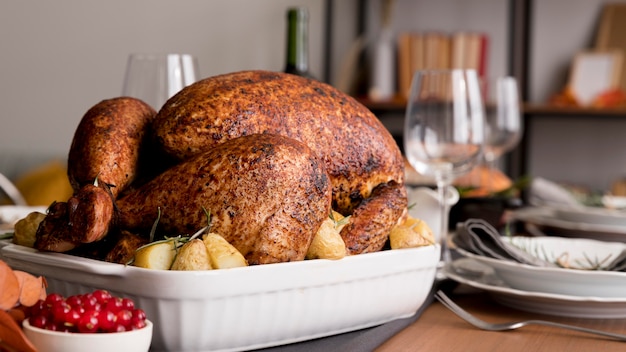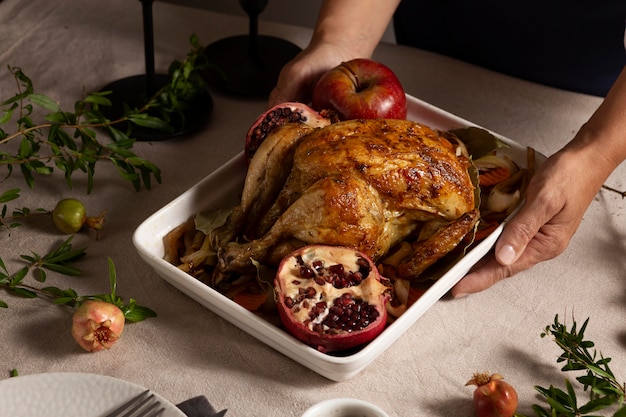The aroma of a perfectly roasted turkey, its golden-brown skin glistening under the festive lights, is a quintessential Christmas tradition. But achieving that picture-perfect bird, bursting with juicy flavour and tender meat, requires more than just tossing it in the oven. It’s about understanding the bird, embracing the process, and mastering the art of roasting. As someone who's spent years perfecting this culinary masterpiece, I'm here to guide you through every step of the way, from choosing the right turkey to carving it with confidence, ensuring a Christmas dinner that's truly unforgettable.
(Part 1) The Foundation of Your Feast: Choosing the perfect turkey

The success of your festive meal hinges on the quality of your turkey. So, let's start with the most important step: choosing the perfect bird. It's not just about picking the biggest one you can find; it's about selecting a turkey that will deliver on flavour and texture.
The Importance of Free-Range: A Taste of Freedom
When it comes to turkey, I always advocate for free-range. Not only does it ensure a more ethical approach to poultry farming, but it also translates to a richer, more complex flavour. The birds have access to fresh air and open spaces, resulting in a higher quality meat that's bursting with flavour.
Bronze vs. White: A Matter of Taste Preference
Now, let's talk breeds. While there's a debate about the "best" breed, I'm a big fan of bronze turkeys. Their dark meat boasts a deep, rich flavour that's hard to beat. White turkeys, on the other hand, are known for their leaner meat, which can be a good choice if you're aiming for a lighter meal. Ultimately, the choice comes down to your personal preference.
Visual Inspection: The Telltale Signs of a Good Bird
Before you grab that turkey, take a closer look. You want a bird with a plump breast and juicy legs, free from any bruises or discoloration. The skin should have a healthy sheen, and the overall appearance should be appealing.
The Sniff Test: A Key to Freshness
The sniff test is crucial. A fresh turkey will have a slightly sweet, poultry-like aroma. If you detect any off-putting odour, it's best to choose another bird.
Size Matters: Finding the Right Fit for Your Feast
For a gathering of 6-8 people, a 12-pound turkey is ideal. It's big enough for everyone to enjoy a generous serving, but not so large that you'll be left with mountains of leftovers.
(Part 2) The Pre-Roast Prep: Setting the Stage for Perfection

You've chosen your turkey, now it's time to get it ready for its star turn. This stage is all about prepping the bird to ensure a deliciously juicy and flavourful outcome.
Thawing Time: A Gentle Awakening
Remember, a frozen turkey needs to thaw properly before roasting. I always recommend thawing it in the refrigerator, allowing ample time for the process. A 12-pound turkey will need approximately 48 hours to thaw completely.
Brining: Unveiling the Secret to Juicy Meat
Brining is a game-changer in the turkey roasting game. It's a technique that involves soaking the turkey in a saltwater solution for several hours, resulting in incredibly juicy and tender meat. The salt draws moisture from the turkey, then re-infuses it, creating a more flavorful and succulent result. I use a simple brine with salt, sugar, and water, but there are endless variations to explore.
Stuffing: A Culinary Choice
Whether to stuff your turkey or not is a personal preference. I prefer to cook my stuffing separately, ensuring it's cooked through thoroughly. This allows for more control over the cooking process, guaranteeing the stuffing is safe to eat. If you decide to stuff your turkey, make sure you do so loosely to allow for proper heat penetration.
Seasoning and Preparation: Adding Your Personal Touch
Pat your turkey dry with paper towels, then generously season it with salt and pepper. Experiment with herbs and spices to enhance the flavour further. I love adding a blend of rosemary, thyme, and sage, but you can create your own unique flavour profile. For an extra touch, you can rub the skin with butter or olive oil, which will help the turkey brown beautifully during roasting.
(Part 3) The Grand Finale: roasting time

Now comes the moment of truth. With your prepped turkey ready to go, it's time to start roasting. This is where the magic happens, transforming your raw bird into a culinary masterpiece.
Oven Temperature: Finding the Sweet Spot
Preheat your oven to 325°F (165°C). This temperature is essential for ensuring even cooking and preventing the turkey from drying out.
The Roasting Rack: Elevating Your Turkey
Place your turkey on a roasting rack inside a large roasting pan. This allows for air circulation, ensuring the bottom doesn't become soggy. It also creates a space for the drippings to collect, which you'll use later for a delicious gravy.
Basting: A Symphony of Moisture and Flavour
Basting is a key step in achieving a truly juicy turkey. It involves using the pan juices to moisten the bird during cooking, adding flavour and preventing the skin from drying out. Baste the turkey every 30-45 minutes, ensuring it's evenly coated.
Timing the Roast: A Balancing Act
As a general guideline, allow 15 minutes per pound for an unstuffed turkey. So, a 12-pound turkey will require approximately 3 hours to roast. However, I always recommend using a meat thermometer to check the internal temperature. Your turkey is ready when it reaches an internal temperature of 165°F (74°C) in the thickest part of the thigh.
(Part 4) Resting Time: Letting Your Turkey Relax
Don't be tempted to carve your turkey immediately after removing it from the oven. Give it a good 30-minute rest before carving. This allows the juices to redistribute throughout the meat, resulting in a more succulent and flavourful carving.
The Art of Resting: A Gentle Approach
Cover your turkey loosely with foil and let it rest in a warm place. The internal temperature will remain above 140°F (60°C) for at least an hour, ensuring the turkey stays safe to eat while the juices settle.
(Part 5) The Art of Carving: Transforming Your Roast
The final act of this culinary journey involves carving your masterpiece. It's a chance to showcase the beautiful, golden-brown turkey and prepare it for your guests to enjoy.
Essential Tools: What You'll Need
For this task, you'll need a sharp carving knife, a carving fork, and a cutting board. The sharp knife is crucial for clean, precise cuts, while the fork is used to hold the turkey steady.
Mastering the Carving Technique: From Breast to Thigh
Start by removing the legs and thighs from the turkey. Then, carve the breast into thin slices, working your way from one side to the other. You can use the carving fork to hold the turkey in place while you slice.
Presentation: A Feast for the Eyes
Arrange the carved turkey beautifully on a platter, alongside roasted vegetables and stuffing. Don't forget to add a touch of elegance with fresh herbs for a finishing touch.
(Part 6) The Magic of Leftovers: Transforming Turkey into Delights
Don't let those leftover turkey scraps go to waste! They're perfect for transforming into delicious new dishes,
turkey salad: A Light and Refreshing Option
Combine leftover turkey with chopped celery, onion, and mayonnaise for a classic turkey salad. Serve it on bread, crackers, or lettuce leaves for a light and refreshing meal.
turkey soup: A Hearty and Comforting Meal
Simmer leftover turkey with vegetables, broth, and spices for a comforting turkey soup. It's the perfect way to use up all those leftovers and enjoy a warm and satisfying meal.
turkey pot pie: A Savoury and Indulgent Treat
Combine leftover turkey with gravy, vegetables, and pastry for a hearty turkey pot pie. It's a great way to use up all those leftovers and enjoy a delicious and satisfying meal.
(Part 7) The Art of Gravy: Elevating Your Feast
No turkey dinner is complete without a rich and flavorful gravy.
Making Gravy from Scratch: A culinary adventure
Using the turkey drippings to create a homemade gravy is a culinary adventure in itself. Deglaze the roasting pan with wine or broth, then whisk in flour and simmer until thickened. You can add herbs and spices for extra flavour.
Adding Flavour: A Symphony of Taste
Experiment with different herbs and spices to enhance the flavour of your gravy. I like to add a touch of rosemary or thyme for an earthy, aromatic touch.
(Part 8) side dishes: Completing Your Feast
No festive meal is complete without a selection of delicious side dishes to complement your turkey.
Roasted Vegetables: A Classic Companion
Roast a variety of vegetables like carrots, potatoes, and Brussels sprouts to accompany your turkey. Season with herbs and spices for added flavour.
Stuffing: A Comforting Choice
Stuffing is a traditional side dish for turkey. Choose a classic sage and onion stuffing, or get creative with your own blend of flavours.
Cranberry Sauce: A Sweet and Tart Counterpoint
A tart cranberry sauce provides a welcome contrast to the richness of the turkey and gravy. You can make it from scratch or opt for a store-bought version.
(Part 9) Dessert: A Sweet Ending to Your Feast
After all that feasting, you deserve a sweet treat.
Christmas Pudding: A Traditional Finale
Christmas pudding is a classic dessert for festive occasions. It's made with dried fruits, spices, and brandy, and is traditionally steamed for several hours.
Mince Pies: A Festive Delight
Mince pies are another popular choice for Christmas. They're filled with a sweet and spiced mincemeat, and are perfect for a post-dinner treat.
Christmas Cake: A Celebration in Cake Form
A rich and decadent Christmas cake is the perfect way to end a festive meal. It's typically decorated with marzipan and icing, and is often kept for several weeks to allow the flavours to develop.
(Part 10) FAQs: Answers to Your Turkey Questions
You've got questions, I've got answers.
Q1: How can I tell if my turkey is cooked?
The best way to check if your turkey is cooked is to use a meat thermometer. Insert it into the thickest part of the thigh, and it should read 165°F (74°C).
Q2: What if my turkey is overcooked?
Overcooked turkey will be dry and tough. You can try to remedy this by adding some pan juices or gravy to the turkey.
Q3: What can I do with leftover turkey?
Leftover turkey can be used in a variety of dishes, including sandwiches, salads, soups, and pies.
Q4: What is the best way to store leftover turkey?
Store leftover turkey in the fridge for up to 4 days, or freeze it for up to 3 months.
Q5: How do I know if my turkey is safe to eat?
If the turkey has been cooked to an internal temperature of 165°F (74°C), and has been stored properly, it is safe to eat.
(Part 11) The Final Word: Enjoy Your Feast
There you have it, your complete guide to roasting the perfect 12-pound turkey. It's about more than just a recipe, it's about creating a delicious and memorable experience. Embrace the process, enjoy the journey, and most importantly, savour the delicious results.
Happy feasting!
Everyone is watching

How to Cook Frozen Lobster Tails Perfectly: A Step-by-Step Guide
RecipesLobster. Just the word conjures up images of lavish meals, special occasions, and a taste of luxury. But let's...

Pigs in a Blanket Cooking Time: How Long to Bake for Perfect Results
RecipesAh, pigs in a blanket. Just the name conjures up images of those delightful little parcels of crispy pastry en...

Pork Fillet Cooking Time: How Long to Cook It Perfectly
RecipesPork fillet, or tenderloin as it's sometimes called, is a real favourite in our house. It's so versatile, and...

The Ultimate Guide to Tender, Juicy Pulled Pork
RecipesRight, let's talk pulled pork. It's one of those dishes that just screams "comfort food," doesn't it? I mean...

The Ultimate Guide to Cooking Sweet Potatoes: From Roasting to Mashing
RecipesSweet potatoes. Just the name conjures up images of warm, comforting dishes, bursts of vibrant color, and a to...
